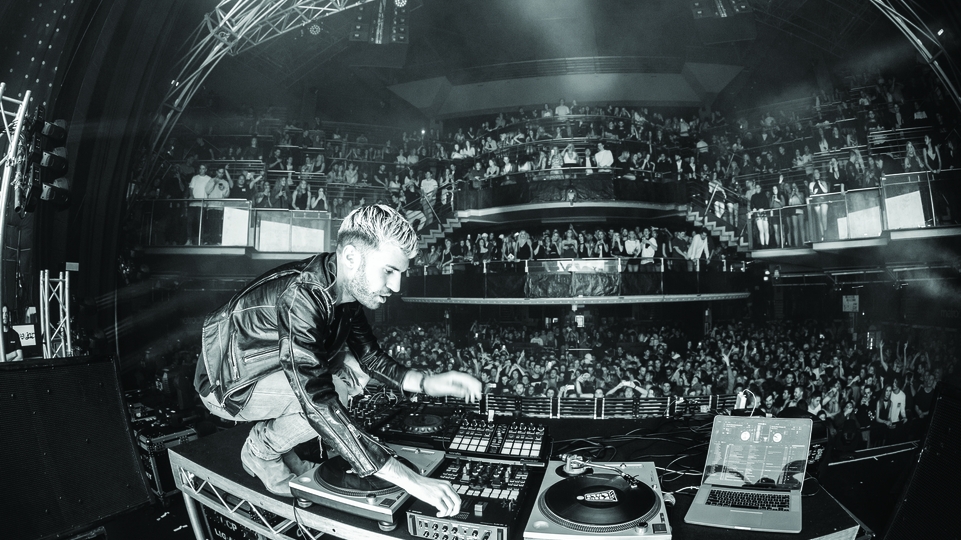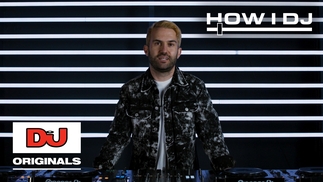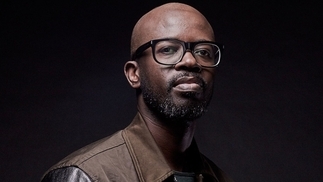DJ Mag Meets A-Trak To Discuss The Fate of Music's Future
The GRAMMY winner tells all...

Owner of music brand Fool’s Gold and youngest DMC champion DJ to this day, Grammy-winning producer A-Trak is a name that has rightfully earned respect and accolades. How will A-Trak spin the fate of music’s future? Allow him to explain...
WORDS: Lily Moayeri || PICS: Shane McCauley
There is a box sitting on the bottom step leading up to A-Trak’s house. No one is trying to climb those stairs to deliver anything and unless someone comes in the front gate or A-Trak leaves, you wouldn’t know there was anything waiting. “Is there a package there?” the music virtuoso, born Alain Macklovitch, shouts from the top. When hearing an affirmative response, and being handed the box, he squeals, “Juice!” which makes him seem like the 15-year-old he was when he won his first of five turntablist awards as the youngest ever Technics/DMC World Champion in 1997.
A-Trak isn’t a teenager anymore, but despite his myriad accomplishments in a wide range of fields, he still has an engaging, youthful air about him. He used to look like a Beastie Boy and have a touch of crankiness to him, but now he kind of looks like his older brother, Dave 1 of Chromeo, except with bleached hair. A-Trak is the malleable model for many brands, among them: Verizon, Adidas, Grey Goose, and Cadillac. He has also collaborated with Nike, New Era, Zoo York and Kidrobot to create original products. His Brooklyn-based Fool’s Gold Records with Nick Catchdubs has gone far beyond a taste-making label into a strong brand that includes a clothing and accessories line, an art gallery and the savagely trendy event series, Day Off. Seemingly, anything associated with A-Trak gives it instant credibility.
He continually rearranges himself on the sectional on the main floor of his sleek open plan home in the Hollywood Hills, trying to find a comfortable position. This sectional is as carefully selected as the rest of A-Trak’s Eames-esque furniture, which stylishly decorates the super-clean minimal lines and blinding whiteness of the space, the kind of look Philippe Starck hotels aspire to—with just as few knick knacks. A-Trak has been here for two years. Prior to this he was in New York for eight years after moving there from his hometown of Montreal. He is getting over a cold and is still a little congested as he shuffles around in socks and slippers, but this doesn’t interfere with how gracious he is, nor does it tamp his hyper-intelligence, thoughtfulness and diplomacy.
“Half the struggle of making music is coming up with the seed of the idea. A remix gives you that seed, that starting point, you just have to decide what to do with it.”
It’s a breath of fresh air to find, despite some seasonal post-nasal drip, A-Trak is a good talker and with the advent of his 10-year retrospective remix compilation, ‘In The Loop’, he has a lot to say. He has penned the liner notes himself, in great detail, something he has gotten used to doing if his expansive, conversational articles for the likes of Huffington Post, Complex and Medium are any indication. 20 years as a DJ with documented formidable skills, A-Trak is one of the few electronic music artists who doesn’t have to have a steady stream of original productions to remain relevant. 10 years ago, however, he started toying with the idea of giving it a try.
“I had all these ideas in my head and wanted to get them out,” he tells DJ Mag USA. “I was definitely aware that anything I released would be held against whatever expectations were tied to my name from my DJ reputation. I didn’t want to half step. I really had to learn to produce and apply a pretty high standard for that transition to work. I worked at it for years.
“I learned how to produce by doing remixes,” he continues, “Half the struggle of making music is coming up with the seed of the idea. A remix gives you that seed, that starting point, you just have to decide what to do with it.”
‘In The Loop’’s track listing is chronological, which is a handy way to observe A-Trak’s growth in the studio. From quirky reworks for Architecture in Helsinki and Scanners to inventive ones for Digitalism, Boys Noize, Sebastien Tellier, his first remixes have more of his personality inserted into them. It’s his slick remix for the Yeah Yeah Yeahs’ ‘Heads Will Roll’ that A-Trak feels was a turning point for his production career.

“The earlier remixes, my identity as a DJ who embraces electronic music was still in progress,” he says. A-Trak got some seriously high profile experience as Kanye West’s tour DJ back in the day, so it’s no surprise when he explains: “A lot of my production choices were informed by my hip-hop background and a mixtape mentality. Patchwork production like Beastie Boys’ ‘Paul’s Boutique’ with samples coming in and out is what I brought to those remixes. Once I got more comfortable with my role as a producer, then I felt more confident. Some of the latter-day remixes I did with the mindset of, ‘If I had produced this song, how would have I have made it?’ It’s hard to remix a song that’s already great. It’s almost easier to take the remix really far from the original so it becomes anecdotal and the remix becomes a track in its own right.”
Whether it’s his remixes of Martin Solveig’s ‘The Night Out’, Phoenix’s ‘Trying To Be Cool’ or Disclosure featuring Lorde’s ‘Magnets’, there is a distinct style to A-Trak’s production. It took a long time for him to get to this point, including an artist album he was working on during his tenure with Yeezy, from 2004 to 2008, which he abandoned. It was particularly important for him to make sure his already carved identity remained intact through this period of “standing next to the sun” as A-Trak likens being in West’s fold. The aforementioned ditched album was meant as a companion to his 2006 DVD, Sunglasses Is A Must, a video collection of footage from A-Trak’s first 10 years of DJing. The DVD—found on YouTube—includes everything from home practices to driving to battles to the shows themselves.
“By 2006, I was no longer only playing hip-hop,” he affirms. “I was the first Serato endorsee ever. That allowed me to grab files of any song library I wanted and jumpstarted the whole idea process of mash-ups and very eclectic mixes. Meanwhile, I was trying to make a turntablist version of DJ Shadow meets RZA meets Madlib meets Dilla with layered samples. Right before I started making the remixes that are on the compilation, I realized, ‘Why am I producing tracks that are slow and moody while I’m out DJing dirty electro to all kinds of hip-hop to dancehall and creating bootlegs and edits for my sets? Shouldn’t my production reflect what I’m playing?’”

While A-Trak’s productions are not numerous they are carefully curated. The same distinct sound heard in his remixes is also in his original work. His singles ‘Push’ with Andrew Wyatt, ’We All Fall Down’ with Jamie Lidell, and ‘Parallel Lines’ with Phantogram feature similar artwork and are musically connected. He’s not sitting on 50 demos that the world hasn’t heard, he’s sitting on maybe four. It was his work as Duck Sauce – A-Trak’s project with Armand Van Helden – that has been most prolific. Their fantastically fun album, ‘Quack’, plays like an awesome ‘70s mixtape, and spawned some dangerously contagious anti-pop earworms that turned into unlikely hits.
No matter how much time he spends in the studio, A-Trak has retained his champion turntablist skills—which could very well be as much of a gift as they are from dedicated practice. Per the DJ himself, the first time he secretly scratched a record on his parents’ turntable, it sounded good. He felt he found his musical instrument. At the most recent EDC Las Vegas, A-Trak played an authentic turntablist set. For this, he went back to practicing, perfecting new tricks using all new songs.
“This past year was almost a revival of turntablism. I feel like the first couple of years of my career, all I cared about were skills. I was the world champion, but I probably only had a couple of hours’ set time, which is hilarious to think about. I was doing six-minute sets in those early years. My last battle was in 2000. After that there was a period of a few years where I worked on perfecting my actual sets. I would interrupt the set with a DMC-style solo but it wasn’t part of the rest of the set. New technology would come out and that would become part of the mixing. My goal was to figure out how to weave those skills into the set without having to start and stop. I worked on that for years and years and years.
"As a technical DJ, I feel responsible to adapt to the new equipment and make sure what I do is looking toward the future using whatever de facto piece of equipment for a DJ is at that point in time."
“I never want turntablism to be an old-school thing,” he advocates. “I want it to feel futuristic, like the way the sonics of electronic music are always futuristic. I think about new generations a lot and influencing people to continue in this direction I’ve gone in. But I don’t want to push them into doing something that would only be feasible on discontinued, defunct equipment.
In layman’s terms, A-Trak sums it up: “I never want to be a regressive artist.”
Even with a firm spot on festival main stages A-Trak is often looked at as the EDM antidote. He is a source of integrity and blanket legitimacy. While he keeps up with every aspect of the times and fits in with everything happening in the scene, he has a strong connection to what propelled him here and has decided to take on the self-appointed job of giving a 360 view of a DJ’s life: the evolution, the ethos and the business, in a book he’s writing about the art as told through his own story.
“DJs are bigger than ever,” he shrugs. “They are the most popular figures in music, yet, there’s this giant paradigm where most people think they want DJing, but they don’t know what a DJ is. There is an appeal to the DJ personalities and characters. It’s funny on social media and cool to see their photos in front of a lot of people. It’s fun to go to the events. That whole thing combined is what people like. Let’s call it DJing.”
Any true-to-form jockey will agree that these days to be a DJ is not this simple. “In reality, the DJ has become the DJ/producer and the producer side is really the focal point, “A-Trak iterates. “I come from an era when a DJ could simply be a DJ. I’m not saying that with nostalgia. I don’t necessarily miss that. I love the current time. Producers put as many hours into their productions as I used to put in on my flares, crabs and scratches. Sadly, DJing is an afterthought. It became the live manifestation of the production.”
A-Trak is organizing his own DJ and beat battle in New York City in the spring of 2017, the Goldie Awards—a nod to Fool’s Gold. The idea is to find the best DJ and the best producer by bringing back the battle scene, connecting it to the current state of DJ culture, and turning the spotlight on the craft of DJing. The battles are particularly aimed at the new generation as a way of encouraging them to push the boundaries of skills and creativity with an understanding of the distinction between a DJ and a producer.
The rules and judging for the DJ battle are more straightforward since the performance is live. With the beat battle, since the beats are pre-made, the rules are more stringent and the judging more complex to force the competitors to bring out their best abilities. To this end, A-Trak is putting together a panel of judges that includes turntablist experts and forward-thinking producers.
“I don’t want to fight the fact that DJing and producing have gotten fused into one,” says A-Trak. “I want to embrace it and bring the whole culture together in front of the same kind of audience I get at Fool’s Gold Day Off, which is a really vibrant, young audience that’s on the pulse of new music. This generation wants to dig deeper. There are a lot of fans that want to see the skills and how something’s made and watch production tutorials. It’s no longer just pop songs and pyro. There is a place for that, but it’s no longer just that.
“The Goldie Awards touch on the bigger ideal of the scene needing leaders and mentors,” he continues. “The scene became more competitive. I’m all for competition, but it also made a lot of DJs act selfishly and feel like they could lose their spot if they didn’t put out a certain amount of music at a certain regularity and it homogenized the sounds.” A-Trak’s ability to pinpoint the current state of DJ culture so perfectly via words is much like his jaw-dropping beat matching skills on the decks.
“There is a constant reversal of roles because sometimes it feels like the crowd is in charge and not the DJ.” We’ve seen A-Trak spin. So, we know that when it comes to owning the crowd, he commands every head-nod, bop and sway with the flick of his crossfader. Or maybe not, maybe it’s a sharing of power between crowd and DJ that results in a heightened shared experience. “I’ve gained this renewed sense of comfort and confidence and inspiration that has come from spending time practicing again,” A-Trak says with a smile. “And that makes the power dance between the crowd and the DJ exhilarating.”






